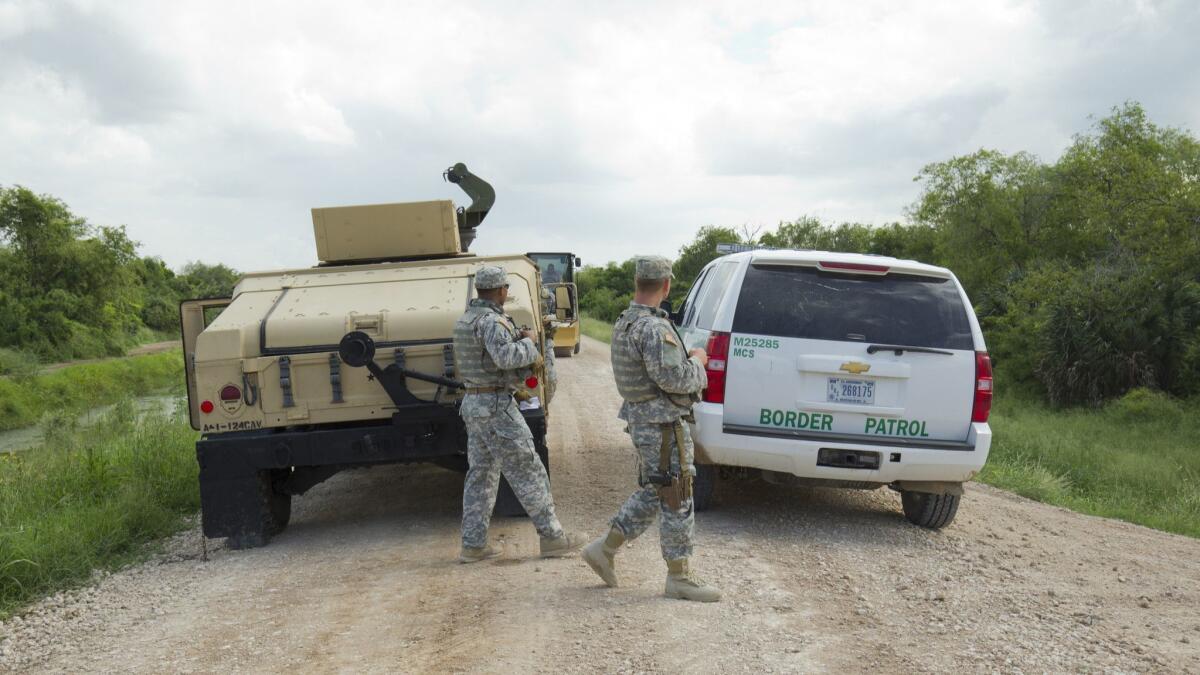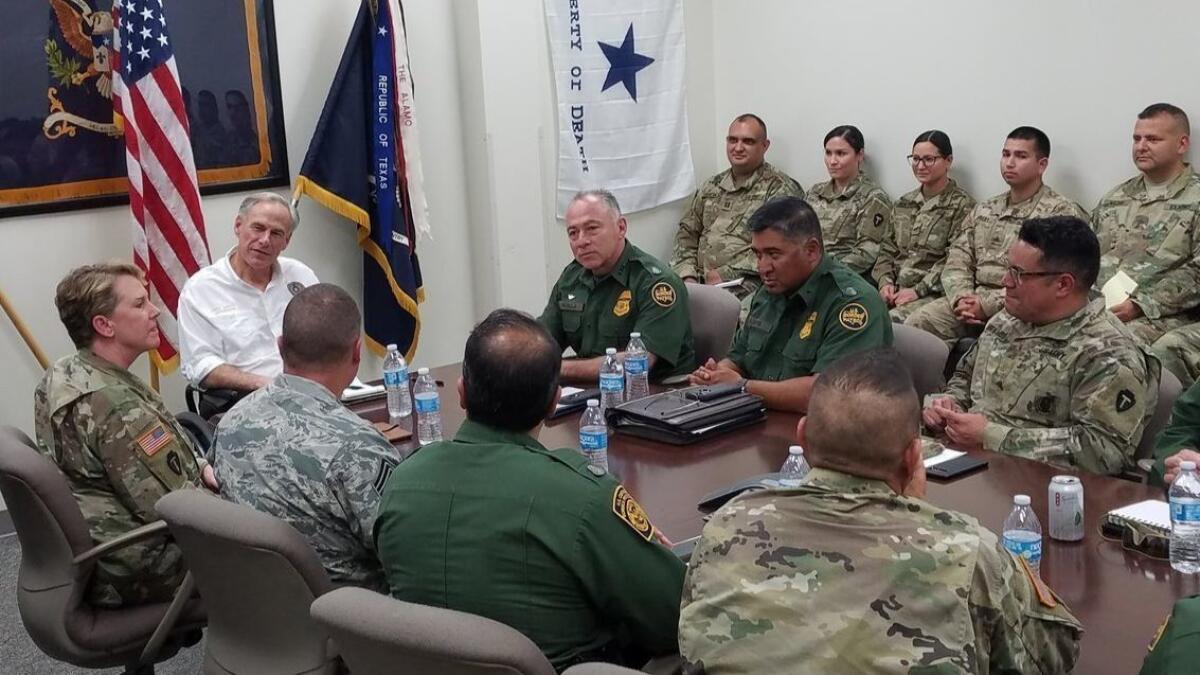Texas governor promotes Trump National Guard plan, but what can troops do?

- Share via
Reporting from Weslaco, Texas — Texas Gov. Greg Abbott has endorsed President Trump’s call to send National Guard troops to the border, and on Thursday echoed that theme in a key spot — the Rio Grande Valley, epicenter of illegal smuggling on the southern border in recent years.
“This operation is necessary in order to deal with an escalation in cross-border traffic,” Abbott said, noting that the number of people crossing the border illegally more than doubled last month compared with this time last year, including more MS-13 gang members and heroin smugglers.
“The cross-border activity is posing serious threats and dangers not only to people in the border region but to people across Texas and the United States,” the Republican governor said, backed by scores of uniformed Texas Guard troops at an armory seven miles north of the border.
Trump has said he expects up to 4,000 added troops to be stationed on the border in Texas, Arizona, California and New Mexico. He announced the deployments last week after tweeting his alarm at reports that a caravan of hundreds of Central American migrants was traveling north through Mexico, bound for the U.S.
But on Thursday, Abbott said “the reason the National Guard was called up has nothing to do with the caravans” but rather with “cross-border activity — people coming across the border and people who are bringing drugs and other contraband into the country.”
“We are on a trajectory that would put us on the lines of the devastating cross-border activity we saw in years like 2014. So the president was right,” Abbott said.
In 2014, the Rio Grande Valley saw a surge in illegal crossings by tens of thousands of unaccompanied youth and families, mostly from Central America. Then-Texas Gov. Rick Perry faulted the federal government for not stepping in, and the state paid to deploy 1,000 National Guard troops. The deployment cost the state $12 million a month initially, but that dropped to about $1 million a month recently as illegal crossings decreased and troops were reduced to about a hundred as of last week.

The latest deployment will be paid for by the federal government, Abbott said, and referred further questions about costs to the Department of Defense. Presidents Obama and George W. Bush also separately deployed the National Guard to the border at an estimated cost of $1.35 billion, according to the Government Accountability Office.
National Guard soldiers will mostly be expected to observe and report illegal smuggling. They cannot arrest, detain or process migrants, Abbott stressed. He and federal officials have said Guard troops will be armed only for self-defense. But they can aid Border Patrol surveillance, running technology like aerostat blimps, helicopters and observation towers, freeing up agents to detain more immigrants, Abbott said.
“What just the Rio Grande Valley sector alone is dealing with is more than 450 apprehensions a day. It has gotten back to levels that are very high,” he said. “The federal government has a duty and responsibility to secure our border.”
Abbott said 762 Texas Guard troops were on the border Thursday, and said that will increase by 300 per week up to 1,400.
“The National Guard is getting calls from some of their members who want to volunteer to participate in this mission,” Abbott said, adding that he also received calls from other state leaders who want to send Guard troops to help.
California Gov. Jerry Brown agreed this week to deploy 400 troops to the border, but stressed that their role is limited. “It will not be a mission to round up women and children or detain people escaping violence and seeking a better life,” the Democrat said in a statement.
The day Trump called for deploying the National Guard, Border Patrol officials in Washington released statistics showing illegal crossings jumped last month. Agents caught 37,393 people, more than twice as many as they did this time last year.
But the monthly increase obscures a longer-term trend: Annual apprehensions have dropped steadily in past decades. Last year, agents caught 310,000 people, the lowest annual total since 1971.
Members of Congress have questioned why the National Guard was needed given the downward trend in apprehensions, how long the deployments will last and what they will cost.
“It’s important for Congress to learn which priorities or programs the military will need to reprogram its funds to pay for this border operation,” Rep. Stephen F. Lynch (D-Mass.) said Thursday at a hearing in Washington.
Some border-area residents welcomed the National Guard’s arrival as a backstop for the Border Patrol, but others dismissed it as a costly, unnecessary political stunt.
John Michael Torres, a spokesman for La Union del Pueblo Entero, a Rio Grande Valley community services group also known as LUPE, said the National Guard deployments were only the latest militarization of the area, which he said has become “ridiculous.”
“When our state did this in 2014, we were also outraged. The idea that we would be responding militarily to a humanitarian situation flies in the face of our values,” said Torres, who brought 40 protesters to the Texas Army National Guard armory on Thursday.
They carried hand-lettered signs that said in Spanish, “No militarization of the border,” “The border says no” and “Families united.”
But Sheriff Benny Martinez of Brooks County, about 70 miles north of the border, said the deployment made sense given news of the migrant caravans and the influx in 2014 that overwhelmed his county and others near the border. Back then border apprehension spiked, but so did deaths.
“We don’t know how many are coming or when they will arrive, but we don’t want to be caught off guard like we were a few years ago,” Martinez said Thursday at a Border Patrol conference in the Rio Grande Valley to address migrant deaths.
Miguel Angel Ortiz, the Salvadoran consul in the Rio Grande Valley, also attended the conference, and said that U.S. immigration officials at times impede Central American migrants’ ability to seek asylum, and that it wasn’t clear what role the National Guard would play.
“We are waiting to see how they function — will they help [Border Patrol] or act?” he said.
Torres noted that in 2014, many valley residents responded to the influx of Central American migrant families by providing food, clothing and other aid. They constructed shelters that still serve a steady flow of migrants, many of them families seeking asylum after fleeing violence.
“We want to see our communities progress, our families get ahead,” Torres said. “We should be devoting resources to healthcare, education, better jobs — not militarization.”
molly.hennessy-fiske@latimes.com
More to Read
Sign up for Essential California
The most important California stories and recommendations in your inbox every morning.
You may occasionally receive promotional content from the Los Angeles Times.











